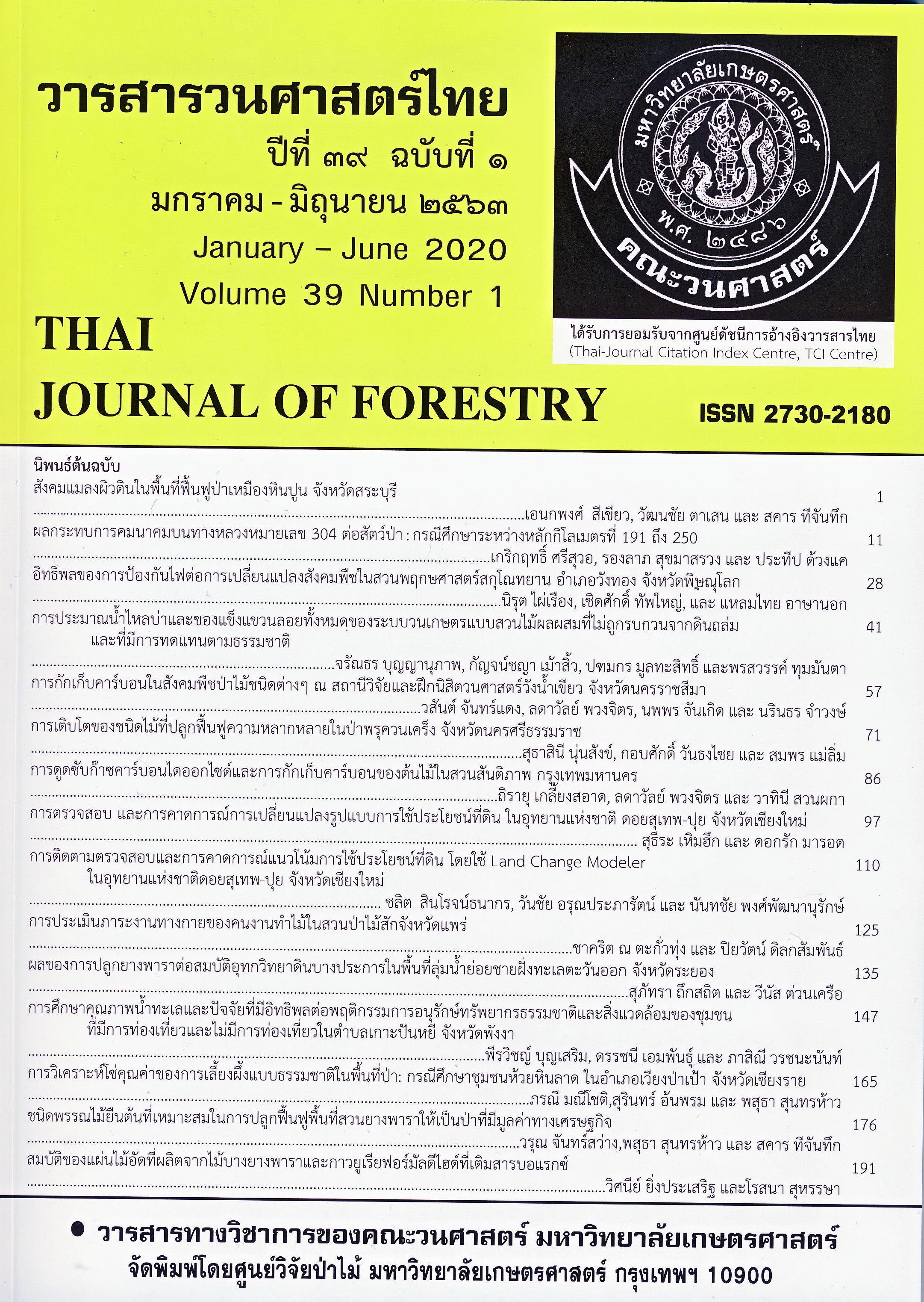สังคมแมลงผิวดินในพื้นที่ฟื้นฟูป่าเหมืองหินปูน จังหวัดสระบุรี
Main Article Content
บทคัดย่อ
การศึกษาความหลากชนิดและสังคมของแมลงผิวดิน ได้ทำการสำรวจในพื้นที่เหมืองหินปูน จังหวัดสระบุรี เพื่อศึกษาผลของการฟื้นฟูป่าต่อการกลับคืนของสังคมแมลงผิวดิน โดยแบ่งพื้นที่ศึกษาออกเป็น 5 พื้นที่ ได้แก่ ป่าดิบแล้ง ป่าเบญจพรรณ พื้นที่ฟื้นฟูมากกว่า 10 ปี พื้นที่ฟื้นฟูน้อยกว่า 10 ปี และพื้นที่ทำเหมือง ทำการเก็บตัวอย่างแมลงผิวดินโดยใช้กับดักหลุม (pitfall-trap) และถุงผ้าแยกตัวอย่างมด (Winkler extractor) ทำการเก็บตัวอย่างทุกเดือน ตั้งแต่เดือนพฤษภาคม พ.ศ. 2558 ถึงเดือนเมษายน พ.ศ. 2559 ผลการศึกษาพบแมลงจำนวนทั้งสิ้น 192 ชนิด 48 วงศ์ 9 อันดับ ซึ่งด้วงในอันดับ Coleoptera พบจำนวนชนิดมากที่สุด 74 ชนิด รองลงมาเป็นอันดับ Hymenoptera และอันดับ Hemiptera จำนวน 57 และ 25 ชนิด ตามลำดับ ส่วนค่าดัชนีความหลากหลาย พบว่า ในพื้นที่ป่าดิบแล้งมีค่าดัชนีของแมลงผิวดินมากที่สุด รองลงมาเป็นพื้นที่ฟื้นฟูมากกว่า 10 ปี ป่าเบญจพรรณ พื้นที่ฟื้นฟูน้อยกว่า 10 ปี และพื้นที่ทำเหมือง มีค่าเท่ากับ 2.97, 2.80, 2.75, 2.55 และ 1.75 ตามลำดับ สำหรับค่าดัชนีความคล้ายคลึง พบว่า บริเวณพื้นที่ป่าดิบแล้งกับพื้นที่ป่าฟื้นฟูมากกว่า 10 ปี และพื้นที่ป่าเบญจพรรณมีค่าความคล้ายคลึงในระดับมากถึงร้อยละ 72 และร้อยละ 70 ส่วนพื้นที่ป่าดิบแล้งกับพื้นที่ทำเหมืองมีค่าความคล้ายคลึงน้อยที่สุดเพียงร้อยละ 43 แสดงให้เห็นว่าการฟื้นฟูป่ามีผลต่อการกลับคืนของสังคมแมลงผิวดินได้ดี
Downloads
Article Details
ข้าพเจ้าและผู้เขียนร่วม (ถ้ามี) ขอรับรองว่า ต้นฉบับที่เสนอมานี้ยังไม่เคยได้รับการตีพิมพ์และไม่ได้อยู่ในระหว่างกระบวนการพิจารณาตีพิมพ์ลงในวารสารหรือสิ่งตีพิมพ์อื่นใด ข้าพเจ้าและผู้เขียนร่วม (ถ้ามี) ยอมรับหลักเกณฑ์และเงื่อนไขการพิจารณาต้นฉบับ ทั้งยินยอมให้กองบรรณาธิการมีสิทธิ์พิจารณาและตรวจแก้ต้นฉบับได้ตามที่เห็นสมควร พร้อมนี้ขอมอบลิขสิทธิ์ผลงานที่ได้รับการตีพิมพ์ให้แก่วารสารวนศาสตร์ คณะวนศาสตร์ มหาวิทยาลัยเกษตรศาสตร์ กรณีมีการฟ้องร้องเรื่องการละเมิดลิขสิทธิ์เกี่ยวกับภาพ กราฟ ข้อความส่วนใดส่วนหนึ่ง หรือ ข้อคิดเห็นที่ปรากฏในผลงาน ให้เป็นความรับผิดชอบของข้าพเจ้าและผู้เขียนร่วม (ถ้ามี) แต่เพียงฝ่ายเดียว และหากข้าพเจ้าและผู้เขียนร่วม (ถ้ามี) ประสงค์ถอนบทความในระหว่างกระบวนการพิจารณาของทางวารสาร ข้าพเจ้าและผู้เขียนร่วม (ถ้ามี) ยินดีรับผิดชอบค่าใช้จ่ายทั้งหมดที่เกิดขึ้นในกระบวนการพิจารณาบทความนั้น”
เอกสารอ้างอิง
Benayas, J.M.R, A.C. Newton, A. Diaz and J.M. Bullock. 2009. Enhancement of biodiversity and ecosystem services by ecological restoration: A meta-analysis. Science 325(5944): 1121-1124.
Diamond, J.M. 1989. The present, past and future of human-caused extinctions. Philosophical Transactions of the Royal Society B Biological Sciences 325: 469-477.
Eisenbeis, G. and W. Wichard. 1987. Atlas on the Biology of Soil Arthopods. Springer-Verlag, Berlin.
Forest and Plant Conservation Research Office. 2009. Methods of Studying Insect Biodiversity. Department of National Parks, Wildlife and Plant Conservation, Bangkok. (in Thai)
Hasin, S. 2008. Diversity and Community Structure of Ants at Sakaerat Environmental Research Station, Nakhon Ratchasima Province. M.S. Thesis, Kasetsart University. (in Thai)
Jaitrong, W. 2011. Key to the Ant Genera in Thailand. Natural History Museum of the National Science Museum, Ministry of Science and Technology, Pathum Thani. (in Thai)
Krebs, J.C. 1972. Ecology: The Experimental Analysis of Distribution and Abundance. Harper and Row Publishers, New York.
Marod, D. and U. Kutintara. 2009. Forest Ecology. Aksorn Siam Printing, Bangkok. (in Thai)
Maxwell Stamp PLC. 2015. The Social and Economic Impacts of Gold Mining. World Gold Council, London.
Mineral Resources and Mining Department. 2017. Rehabilitation of Mining Site. Siam Cement Group, Bangkok. (in Thai)
Mound, L.A. and N. Waloff. 1978. Diversity of Insect Faunas. Symposia of the Royal Entomological Society of London No. 9. Blackwell Scientific Publications, New York.
Nichols, E., T. Larsen, S. Spector, A.L. Davis, F. Escobar, M. Favila and K.Vulinec. 2007. Global dung beetle response to tropical forest modification and fragmentation: A quantitative literature review and meta-analysis. Biological Conservation 137(1): 1-19.
Noitubtim, P., S. Teejuntuk and K. Wanthongchai. 2012. Structural characteristics of insect population in reclamation process area at Kaeng Khoi limestone mining, Saraburi province. Thai Journal of Forestry 31(1): 1-9. (in Thai)
Pannavalee, R., D. Wiwatwittaya and S. Suksard. 2016. Terrestrial ant communities structure in Kasetsart University, Bangkhen campus, Bangkok. Thai Journal of Forestry 35(2): 1-10. (in Thai)
Pozsgai, G., N.A. Littlewood. 2014. Ground beetle (Coleoptera: Carabidae) population declines and phenological changes: Is there a connection? Ecological Indicators 41: 15-24.
Sánchez-Bayo, F. and K.A.G. Wyckhuys. 2019. Worldwide decline of the entomofauna: A review of its drivers. Biological Conservation 232: 8-27.
Senthong, D. 2003. Ants Distribution Base on Air Quality Variation in Urban Community of Bangkok. M.S.Thesis, Mahidol University. (in Thai)
Subinprasert, S. 2003. Insect Biology. Ramkhamhaeng University Press, Bangkok. (in Thai)
Thai Meteorological Department. 2017. Seasonal in Thailand. Thai Meteorological Department, Bangkok. (in Thai)
Wiwatwitaya, D. 1996. Biodiversity of forest insects: soil insects, pp. 430-443. In Seminar on biodiversity-Utilization-Conservation-Research. 20-22 September 1996. Biodiversity Establishment Center Project, Kasetsart University, Bangkok. (in Thai)
Wiwatwitaya, D. 2006. Ant museum. Kasetsart Extension Journal 52 (1): 13-21. (in Thai)


